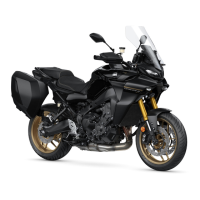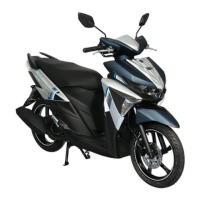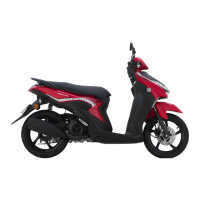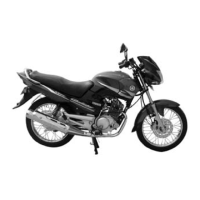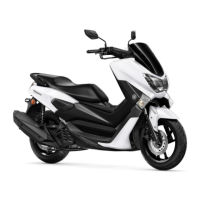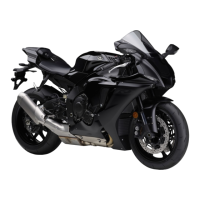Do you have a question about the Yamaha GT1 and is the answer not in the manual?
Overview of the GT1 model's appearance.
Overview of the GTMX model's appearance.
Key characteristics and advantages of the GT1-GTMX motorcycle.
Technical data and performance metrics for both models.
Graphical representation of engine and driving performance.
Listing of necessary tools for maintenance and repair.
Explanation of the automatic lubrication system.
Benefits and advantages of the Autolube system.
Procedures for oil pump maintenance, checking, and adjustment.
Steps for adjusting the carburetor and autolube cables.
Procedure for bleeding the autolube oil pump.
Details on the reed valve's design and proper care.
Explanation of piston movement and its effect on torque induction.
Step-by-step guide to removing the engine from the chassis.
Procedures for removing and inspecting the reed valve assembly.
Instructions for removing and installing the cylinder head.
Details on cylinder wear checking, reconditioning, and installation.
Steps for removing and fitting the piston pin.
Methods for installing, checking, and removing piston rings.
Guidance on checking piston clearance and installation direction.
Procedures for removing and installing the right-hand crankcase cover.
Detailed inspection and maintenance of the clutch assembly.
Steps for removing and inspecting the primary drive gear.
Explanation of the kick starter system and its components.
Description of the gear shifting system and its operation.
Instructions for removing and checking the drive sprocket.
Procedures for separating and reassembling the crankcase halves.
Overview of the transmission gears, ratios, and layout.
Detailed steps for removing and checking the front wheel assembly.
Procedures for removing and inspecting the rear wheel assembly.
Instructions for removing, checking, and adjusting the rear sprocket.
Information on recommended tire pressures for riding.
Steps for removing, disassembling, and assembling front forks.
Procedure for checking the condition of rear shock absorbers.
Instructions for removing the fuel tank from the frame.
Steps for removing, checking, and replacing swing arm components.
Guidance on checking steering head bearings and balls for wear.
Location and function of these chassis components.
Description of the frame's design, construction, and mounting points.
Information on the handlebars and meter bracket mounting.
Details on the footrest and engine guard construction.
Overview of the ignition system's flywheel magneto.
List of electrical components and their manufacturers.
Wiring diagrams for GT1 and GTMX electrical systems.
Explanation of how the ignition system generates spark.
Procedure for setting the ignition timing using a dial indicator.
Specifications and testing methods for the ignition coil.
Function and testing procedures for the ignition condenser.
Details on charging system components and capacity testing.
Information on battery specifications, service life, and storage.
Procedure for checking the main switch continuity.
Guidance on spark plug inspection, cleaning, and replacement.
Details on headlight, taillight, horn, and speedometer systems.
Overview of the GT1 model's appearance.
Overview of the GTMX model's appearance.
Key characteristics and advantages of the GT1-GTMX motorcycle.
Technical data and performance metrics for both models.
Graphical representation of engine and driving performance.
Listing of necessary tools for maintenance and repair.
Explanation of the automatic lubrication system.
Benefits and advantages of the Autolube system.
Procedures for oil pump maintenance, checking, and adjustment.
Steps for adjusting the carburetor and autolube cables.
Procedure for bleeding the autolube oil pump.
Details on the reed valve's design and proper care.
Explanation of piston movement and its effect on torque induction.
Step-by-step guide to removing the engine from the chassis.
Procedures for removing and inspecting the reed valve assembly.
Instructions for removing and installing the cylinder head.
Details on cylinder wear checking, reconditioning, and installation.
Steps for removing and fitting the piston pin.
Methods for installing, checking, and removing piston rings.
Guidance on checking piston clearance and installation direction.
Procedures for removing and installing the right-hand crankcase cover.
Detailed inspection and maintenance of the clutch assembly.
Steps for removing and inspecting the primary drive gear.
Explanation of the kick starter system and its components.
Description of the gear shifting system and its operation.
Instructions for removing and checking the drive sprocket.
Procedures for separating and reassembling the crankcase halves.
Overview of the transmission gears, ratios, and layout.
Detailed steps for removing and checking the front wheel assembly.
Procedures for removing and inspecting the rear wheel assembly.
Instructions for removing, checking, and adjusting the rear sprocket.
Information on recommended tire pressures for riding.
Steps for removing, disassembling, and assembling front forks.
Procedure for checking the condition of rear shock absorbers.
Instructions for removing the fuel tank from the frame.
Steps for removing, checking, and replacing swing arm components.
Guidance on checking steering head bearings and balls for wear.
Location and function of these chassis components.
Description of the frame's design, construction, and mounting points.
Information on the handlebars and meter bracket mounting.
Details on the footrest and engine guard construction.
Overview of the ignition system's flywheel magneto.
List of electrical components and their manufacturers.
Wiring diagrams for GT1 and GTMX electrical systems.
Explanation of how the ignition system generates spark.
Procedure for setting the ignition timing using a dial indicator.
Specifications and testing methods for the ignition coil.
Function and testing procedures for the ignition condenser.
Details on charging system components and capacity testing.
Information on battery specifications, service life, and storage.
Procedure for checking the main switch continuity.
Guidance on spark plug inspection, cleaning, and replacement.
Details on headlight, taillight, horn, and speedometer systems.
| Fuel System | Fuel injection |
|---|---|
| Ignition System | TCI |
| Lubrication System | Wet sump |
| Front Suspension | Telescopic fork |
| Displacement | 124 cm3 |
| Starting System | Electric starter |
| Engine Oil Capacity | 1.0 L |
| Front Brake | Single disc |
| Rear Brake | Drum |
| Rear Tire | 90/90-14M/C 46P Tubeless |

